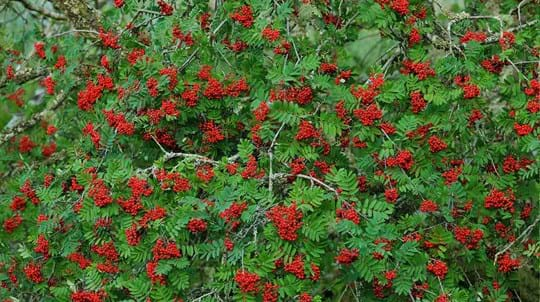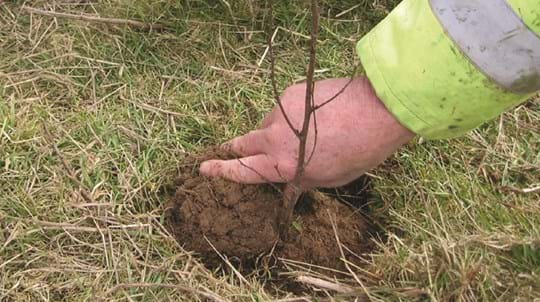Buy British trees from our shop
We have single trees and tree packs to meet your needs, from wildlife to woodfuel. Delivery is free.
Shop now
Content editor
Small garden, big impact – here’s how to plant the right tree in the right place to help combat global warming from home.
We’re in for some intense weather. After 2022's record temperature highs, it’s hard to look away. Climate change is happening, but you can help protect your own corner of the world.
Trees are a powerful weapon against global warming. A single broadleaf tree can store carbon in its trunk and in the soil below.
Whether you have a small garden or a whole landscape on your doorstep, planting trees, shrubs or hedges can help reduce the damage for people, plants and wildlife in times of extreme weather.
Each tree in your garden will filter the air around it, absorbing pollutants and locking up carbon in its trunk, roots and the soil. It can slow the fall of heavy rain and help drink up water from intense storms. It can scatter the sun’s hot rays, giving shade to cool the air and allowing life to thrive beneath.
Species of wildlife depend on every tree for different reasons. As temperatures rise, water supplies suffer and natural cycles change. Planting more trees increases the chance for wildlife to secure food and shelter during increasing times of trial.
Imported tree species can spread harmful tree diseases and pests. Visit our tree shop to find native saplings which have been sourced and grown on home soil.
The answer is nearly impossible to pin down, because experts measure carbon absorption by hectares of woodland. But, tree species that live the longest will absorb the most carbon. Garden trees don’t always have a guaranteed place for their whole lifespan, so pick a species that grows quickly and reaches maturity early.
Many trees can be pruned and coppiced to suit smaller spaces. Here’s a list of trees and shrubs that don’t take up much room but can make a big difference to the planet.
The crab apple’s irregular rounded shape is great for casting shade and cooling the air. In spring, enjoy the company of butterflies and bees that visit its sweet-scented white blossom. The fruit can be used in a number of tasty crab apple recipes – grow your own to try at home.
Height: Up to 10 metres.
Environmental value: A trooper in dry seasons, the crab apple is considered drought tolerant. Its leaves are a food source for the caterpillars of many moths. Pollinators enjoy an early blooming season, finding an important source of pollen and nectar from early spring. The fruit is popular among birds like blackbirds, thrushes and crows, as well as mammals like mice, voles, foxes and badgers.
Preferred conditions: The crab apple can tolerate full sun and most soil types – it’s partial to dryness, making it an excellent choice to endure droughts.
Juniper is a much-loved evergreen that grows as a shrub or small tree. Its hardy nature and year-round foliage allow it to absorb carbon at a steady pace. With dense branches and pointy leaves, juniper will cast shade in your garden and help keep small wildlife safe from garden predators like cats.
Height: Up to 10 metres.
Environmental value: A popular nesting spot, juniper provides dense cover for small birds such as goldcrest. The fruit is a favourite among birds including fieldfare, song thrush, mistle thrush and ring ouzel.
Preferred conditions: Juniper grows well in full sun and well-drained soil types, making it one of the more capable trees in withstanding drought.
We have single trees and tree packs to meet your needs, from wildlife to woodfuel. Delivery is free.
Shop nowOur leaf ID swatch book is the perfect pocket guide. Learn to recognise leaves and twigs from 30 common UK trees and shrubs.
Expect a burst of yellow catkins to brighten your outdoor space in chilly winters. The osier willow is an exceptionally fast grower, gaining an estimated 100cm each year until mature. Known commonly as ‘basket willow’, its flexible branches can be used for weaving – lower your carbon footprint by making your own baskets!
Height: Up to 7 metres.
Environmental value: Introduced in ancient times, the osier willow has long since benefitted native plant and wildlife species and is naturalised in the UK. Birds enjoy nesting among the branches and its catkins provide an important source of early nectar and pollen for pollinators. Caterpillars of moth species like the lackey, herald and red-tipped clearwing feed on the foliage.
Preferred conditions: Often found in wet areas such as riversides. Common osier prefers full sunlight and grows best in non-alkaline soils.
When coppiced, hazel can capture carbon for several hundred years – but it only takes three to five years for the first harvest of tasty hazelnuts. Read our top tips on hazelnut foraging and recipe ideas.
Height: Up to 10 metres.
Environmental value: Hazel is a fast grower and a favourite among birds, caterpillars, squirrels and even dormice. You’ll have to get in quick before the nuts are all gone!
Preferred conditions: This tree grows best in non-acid, well-drained to moist soils.
Blackthorn grows as a shrub and can become an attractive tree once mature. White blossom will bring extra charm to your garden in early spring and turn to purple-black fruits (sloes) in late summer. Sloes are popular for making sloe gin, a tasty way to celebrate the festive season when winter comes. As a source of food and shelter for an abundance of species, the blackthorn is vital for supporting biodiversity in times of challenging temperatures.
Height: Up to 7 metres, growing an estimated 40-60cm each year until mature.
Environmental value: Early flowering, blackthorn is an essential source of pollen and nectar for bees and butterflies like the black and brown hairstreak. Its foliage feeds the caterpillars of many moths while birds nest among the thorny thickets, eating insects and sloes. Blackthorn is quick to mature and doesn’t take long to begin capturing carbon.
Preferred conditions: Moist, well-drained soil and prefers full sunlight.
Although better suited for medium to large gardens, silver birch's compact, shallow roots do allow it to grow in tighter spots. This tree's light, open canopy enables grasses, mosses and flowers to grow beneath, and it's pretty bark is white all year-round.
Height: Up to 30 metres.
Environmental value: Birch trees support over 520 different insect species. Small birds such as long-tailed tit, siskin, greenfinch and redpoll are attracted by the abundant seeds and insects that it hosts.
Preferred conditions: Can grow in most conditions but prefers sandy or acidic soils.
We have single trees and tree packs to meet your needs, from wildlife to woodfuel. Delivery is free.
Shop now
Blog
Joe Bates • 04 Oct 2018

Plant trees
Follow our guide to three of the most successful ways to plant.

Trees woods and wildlife
Trees are one of the best natural climate change solutions. Find out how they lock up carbon and how many the UK needs to reach carbon net zero by 2050.